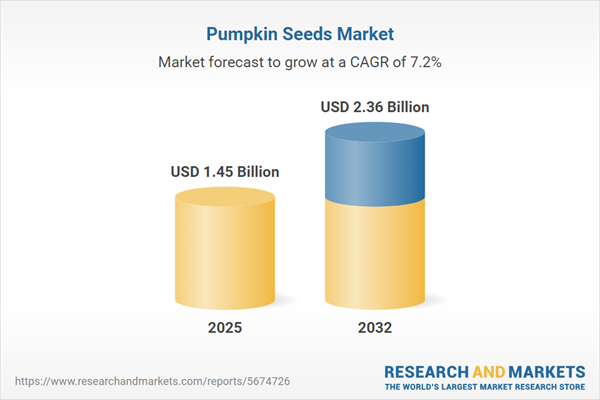Speak directly to the analyst to clarify any post sales queries you may have.
Senior decision-makers in the pumpkin seeds market are managing significant shifts, balancing regulatory requirements with innovation and evolving preferences for wellness-driven products. As the landscape transforms, leaders who prioritize operational agility and transparent supply chains are best positioned to capture sustainable growth.
Pumpkin Seeds Market Snapshot
The global pumpkin seeds market is projected to reach USD 1.35 billion in 2024, increase to USD 1.45 billion in 2025, and is anticipated to achieve USD 2.36 billion by 2032.
This steady upward trajectory is anchored by the rising demand for wellness-centric ingredients among both B2B and retail customers. As industry stakeholders—from multinationals to agile new entrants—meet intensifying consumer and regulatory expectations, they are adapting operations, expanding product offerings, and enhancing their competitive approaches. Growth is driven by expanding uses, regional regulatory shifts, and the integration of pumpkin seeds into emerging food industry applications, influencing both procurement practices and end-user consumption patterns.Pumpkin Seeds Market: Scope & Segmentation
- Form: Product ranges include flavored, organic, raw, roasted, and salted pumpkin seeds, addressing mainstream and premium segments. Consumer demand for clean-label ingredients strongly influences selection criteria across retail and industrial channels.
- End User: Food manufacturers, foodservice businesses, and direct-to-consumer buyers represent key markets. The introduction of new product formats allows access to additional retail and B2B offerings, supporting ongoing business expansion.
- Application: Pumpkin seeds are utilized in bakery products, snacks, confectionery, specialty and gourmet items, and multi-ingredient blends. This versatility supports engagement in innovation-oriented, higher-margin sectors.
- Packaging: Bulk options, such as bags and barrels, strengthen efficiency for high-volume buyers, while pouches, jars, and boxes increase appeal and convenience for individual consumers.
- Distribution Channel: Distribution spans supermarkets, specialty retailers, hypermarkets, convenience shops, and online platforms, giving suppliers broad market access and responsiveness to evolving purchase behavior.
- Geographic Coverage: North America, Europe, the Middle East, Africa, and Asia-Pacific each feature distinct regulations and consumer priorities. Companies adapt strategies to align with local compliance needs and maximize market relevance.
- Company Developments: Enterprises like Archer Daniels Midland Company, Cargill, Bunge Limited, and John B. Sanfilippo & Son focus on portfolio optimization and strategic partnerships. These efforts enhance supply resilience, streamline production, and improve procurement efficiency throughout the sector.
Pumpkin Seeds Market: Key Takeaways for Senior Decision-Makers
- Increasing supply chain transparency and traceability is vital for trust-building and aligns with corporate sustainability and compliance initiatives.
- Investment in plant-based protein integration and botanical blends enables companies to address the trend for natural, health-focused foods while ensuring product differentiation.
- Implementing digital engagement strategies, especially advanced direct-to-consumer and business channels, supports operational flexibility and strengthens resilience during rapid market changes.
- Enhanced collaboration among producers and suppliers accelerates resource management and streamlines development cycles, fostering quick adaptation to market opportunities and risks.
- Regional market approaches are essential: innovation propels demand in the Americas, regulation shapes growth in EMEA, and urbanization in Asia-Pacific boosts demand for nutrient-rich food options.
Tariff Impact: Strategic Market Repercussions
Forthcoming U.S. tariffs scheduled for 2025 prompt organizations to reassess sourcing and distribution models. Efforts such as localizing processing, renegotiating supplier terms, and applying advanced analytics to map supply chain risks are helping safeguard profit margins and continuity. These adjustments maintain business resilience during dynamic trade shifts.
Methodology & Data Sources
This market analysis synthesizes insights from executive interviews, industry-specific surveys, trade literature, regulatory databases, and worldwide agricultural data. The research methodology identifies critical trends and actionable intelligence for sector leaders managing transformation in the pumpkin seeds market.
Pumpkin Seeds Market: Why This Report Matters
- Equips senior leaders with relevant, data-driven insights to proactively monitor regulatory, supply-side, and consumer dynamics within the pumpkin seeds market.
- Enables identification of emerging portfolio opportunities and assists in refining investment priorities as market conditions and competition evolve.
- Facilitates robust risk management and regulatory compliance, helping organizations sustain operational flexibility and readiness for change.
Conclusion
Sustained growth in the pumpkin seeds market is driven by ongoing innovation, tailored strategies by region, and resilient supply chains. This report offers senior leaders a comprehensive decision-support resource for long-term, strategic advancement.
Additional Product Information:
- Purchase of this report includes 1 year online access with quarterly updates.
- This report can be updated on request. Please contact our Customer Experience team using the Ask a Question widget on our website.
Table of Contents
3. Executive Summary
4. Market Overview
7. Cumulative Impact of Artificial Intelligence 2025
Companies Mentioned
The companies profiled in this Pumpkin Seeds market report include:- Archer Daniels Midland Company
- Cargill, Incorporated
- Bunge Limited
- John B. Sanfilippo & Son, Inc.
- PepsiCo, Inc.
- The Kellogg Company
- Conagra Brands, Inc.
- Calbee, Inc.
- Utz Brands, Inc.
- Hain Celestial Group, Inc.
Table Information
| Report Attribute | Details |
|---|---|
| No. of Pages | 192 |
| Published | November 2025 |
| Forecast Period | 2025 - 2032 |
| Estimated Market Value ( USD | $ 1.45 Billion |
| Forecasted Market Value ( USD | $ 2.36 Billion |
| Compound Annual Growth Rate | 7.1% |
| Regions Covered | Global |
| No. of Companies Mentioned | 11 |









